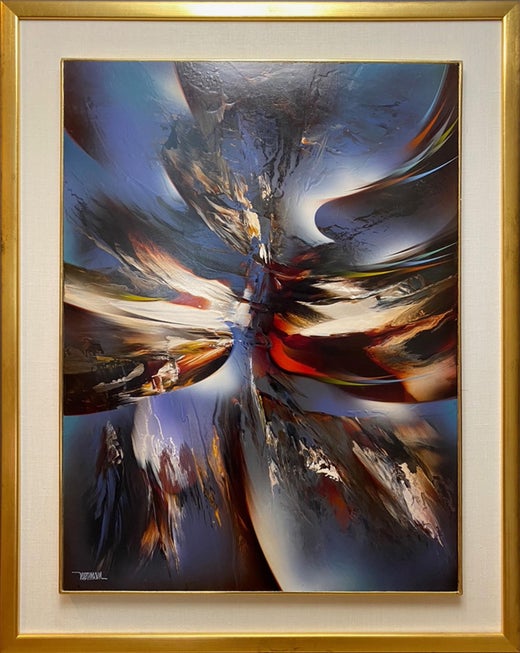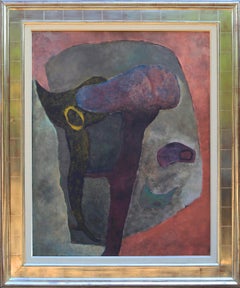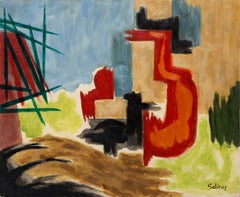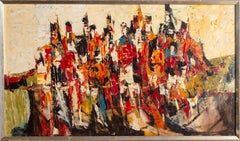Want more images or videos?
Request additional images or videos from the seller
1 of 8
Leonardo NiermanEnchanted Ship, Abstract Expressionist Oil Painting by Leonardo Niermancirca 1970
circa 1970
$5,500List Price
About the Item
- Creator:Leonardo Nierman (1932, Mexican)
- Creation Year:circa 1970
- Dimensions:Height: 31 in (78.74 cm)Width: 39 in (99.06 cm)
- Medium:
- Movement & Style:
- Period:
- Condition:
- Gallery Location:Long Island City, NY
- Reference Number:Seller: RO846281stDibs: LU46615961302
Leonardo Nierman
Leonardo Nierman is a Mexican abstract artist. His varied paintings and sculptures are inspired by both nature and classical musicians like Johann Sebastian Bach and Claude Debussy, as well as an array of artists that includes David Alfaro Siqueiros, Wassily Kandinsky, and Joan Miró. Nierman’s paintings utilize bright colors and evoke elemental natural events like volcanic eruptions, storms, and waterfalls. In the same vein, his sculptures often depict abstracted sublime representations of angelic figures and flames. Born on November 1, 1932 in Mexico City, Mexico to Lithuanian and Ukrainian parents, Nierman studied the violin from a very young age before receiving a BA in business administration from the Universidad Nacional Autónoma de México. Today, the artist’s works are in the collections of the Museum of Modern Art in Mexico City, the Museum of Fine Arts in Boston, the Detroit Institute of the Arts, and the Indianapolis Museum of Art, among others. Nierman lives and works in Mexico City, Mexico.
About the Seller
4.9
Platinum Seller
Premium sellers with a 4.7+ rating and 24-hour response times
Established in 1979
1stDibs seller since 2014
3,197 sales on 1stDibs
Typical response time: 1 hour
Authenticity Guarantee
In the unlikely event there’s an issue with an item’s authenticity, contact us within 1 year for a full refund. DetailsMoney-Back Guarantee
If your item is not as described, is damaged in transit, or does not arrive, contact us within 7 days for a full refund. Details24-Hour Cancellation
You have a 24-hour grace period in which to reconsider your purchase, with no questions asked.Vetted Professional Sellers
Our world-class sellers must adhere to strict standards for service and quality, maintaining the integrity of our listings.Price-Match Guarantee
If you find that a seller listed the same item for a lower price elsewhere, we’ll match it.Trusted Global Delivery
Our best-in-class carrier network provides specialized shipping options worldwide, including custom delivery.You May Also Like
Mid Century Abstract Expressionist Cityscape
Located in Soquel, CA
Wonderful mid century abstract expressionist landscape of bridge over water cityscape, circa 1960. Illegible signature lower left ("Aioli"?). Conditi...
Category
1960s Abstract Expressionist Abstract Paintings
Materials
Masonite, Oil
Edge
Located in Austin, TX
Waterline Fine Art, Austin, TX is pleased to present the following work:
Oil on board. Signed and dated lower right and verso, titled verso.
36.25 x 48 in.
40.5 x 52.25 in. (framed)
Framed in contemporary silver, tiered floater frame.
Dennis Eugene Norman Burton was a Canadian modernist who was born in Lethbridge, Ontario. He attended the Ontario College of Art from 1952 to 1956, and worked for the Canadian Broadcasting Corporation (CBC) as a graphic designer until 1960.
Inspired by a 1955 exhibition of the “Painters Eleven” at Toronto’s Hart House, as well as American Abstract Expressionist artists such as Robert Motherwell, Jack Tworkov, and Willem de Kooning, Burton shifted his focus toward abstraction in the mid-1950s.
Burton showed with the famed Isaacs Gallery in Toronto, becoming one of the youngest members on the gallery’s roster. A talented musician, he also played saxophone in the Artist’s Jazz Band in Toronto - a pioneering Canadian free-jazz group...
Category
1950s Abstract Expressionist Abstract Paintings
Materials
Masonite, Oil, Board
Colorful Modernist Still Life with Impasto Flowers Style of Emily Sillman
Located in Soquel, CA
Colorful Modernist Still Life with Impasto Flowers by Ellis Hopkins (American, b. 1952).
This bold still life features an array of flowers as its central focus. The painting is ren...
Category
Late 20th Century Abstract Expressionist Abstract Paintings
Materials
Oil, Board, Masonite
$3,150
H 36.07 in W 30 in D 0.13 in
Russian School Abstract Composition, 1988
Located in Astoria, NY
Russian School, Abstract Composition, Oil on Masonite, 1988, illegibly signed in Russian and dated lower right, inscribed in pencil to verso, painted frame. Overall: 11.25" H x 15.5"...
Category
1980s Abstract Expressionist Abstract Paintings
Materials
Masonite, Oil, Wood
Abstract Earth Tone Textured Square Landscape
Located in Soquel, CA
A textural, earth tone abstract landscape evocative of rolling hillsides in brown and white neutrals by an unknown artist (American, 20th Century). Unsigned. Unframed. Image, 24"H x...
Category
1980s Abstract Expressionist Abstract Paintings
Materials
Fabric, Masonite, Oil
America Rising - Patriotic 9/11 Figurative Abstract
By Jocelyn Audette
Located in Soquel, CA
Vivid and evocative abstracted painting of 9/11 by artist Jocelyn Audette (American, b. 1952), circa 2001. Impasto adds texture and interest. Label on verso with artist's name. Pres...
Category
Early 2000s Abstract Expressionist Abstract Paintings
Materials
Oil, Masonite
$680 Sale Price
20% Off
H 26 in W 22 in D 1.5 in
The Investigation of the Investigation, abstract oil, bold colorful dots & grey
By C. Dimitri
Located in Brooklyn, NY
Oil, acrylic, resin on masonite
Category
2010s Abstract Expressionist Abstract Paintings
Materials
Resin, Masonite, Oil, Acrylic
$2,700
H 48 in W 48 in D 2.01 in
"7 Koi" Expressionist Brightly Colored Koi Underwater in Red/Yellow/Blue/Green
By Linda Holt
Located in Wellesley, MA
"7 Koi" is a complex work of koi fish swimming underwater filled with light and brilliant color painted in a lush and fluid style bordering on abstraction. Fish are in shades of ...
Category
2010s Abstract Expressionist Figurative Paintings
Materials
Oil, Masonite
$2,600
H 12 in W 16 in D 2 in
" Albero rosa" by Enzio Wenk, 2018 - Oil Paint on Masonite, Expressionism
By Enzio Wenk
Located in Bresso, IT
Translated title: "Pink tree".
Oil paint on masonite.
Category
2010s Abstract Expressionist Abstract Paintings
Materials
Masonite, Oil
$1,317
H 27.56 in W 19.69 in D 1.19 in
"Quickening" Female Abstract Expressionist Artist 1970 Red Black White LARGE OIL
By Suzanne Bloomfield
Located in Rancho Santa Fe, CA
Born in 1934, the work of Suzanne Bloomfield represents the life force which binds us all -- a universal symbol for the soul's transformation.
Bloomfield believes that painting is the discovering of beautiful secrets which are only uncovered in the searching.
Her painting blends encaustic (an ancient painting method which adds pigment to heated beeswax) with oils.
Her selected exhibitions include: Permanent Collection Archives, American Album, The National Museum of Women in the Arts, Washington, DC; Foreign Exhibition Tour of India, National Association of Women Artists-Centennial Year, New York City; and International Latin American Exposition, Miami Florida.
"Quickening" Female Abstract Expressionist Artist 1970 Red...
Category
1970s Abstract Expressionist Abstract Paintings
Materials
Masonite, Encaustic, Oil
More From This Seller
View AllThe Two Furies, Surrealist Abstract Oil Painting on Masonite by Theodoros Stamos
By Theodoros Stamos
Located in Long Island City, NY
Completed when the artist was only 25, this painting references a fight between two mythological figures. Commonly called Furies, the Erinyes or Eumenides were Greek goddesses of ven...
Category
1940s Abstract Expressionist Abstract Paintings
Materials
Masonite, Oil
Abstract Exterior, Oil Painting by Laurent Marcel Salinas
By Laurent Marcel Salinas
Located in Long Island City, NY
Artist: Laurent Marcel Salinas, French (1913 - 2010)
Title: Untitled, Grass 263
Medium: Oil on Masonite, signed LR
Size: 15 x 18 inches
Category
1950s Abstract Expressionist Abstract Paintings
Materials
Masonite, Oil
Highland Figures, Abstract Expressionist Acrylic Painting by John Kinnear
Located in Long Island City, NY
Artist: John Kinnear, Canadian (1922 - 2003)
Title: Highland Figures
Medium: Acrylic on masonite, signed lower right
Date: circa 1960
Image Size: 22 x 38 ...
Category
1960s Abstract Expressionist Abstract Paintings
Materials
Masonite, Acrylic
White Landscape, Abstract Expressionist Collage by Keith Morrow Martin 1959
Located in Long Island City, NY
An abstract collage on wood by Kenneth Morrow Martin, American (1911-1983). Exhibited: 1st Knoxville Art Center National Exhibtion, 1961
White Landscape by Keith Morrow Martin...
Category
1950s Abstract Expressionist Mixed Media
Materials
Masonite, Varnish, Magazine Paper
Abstract 3, Abstract Expressionist Oil Painting on Paper by Isabel Gamerov
By Isabel Gamerov
Located in Long Island City, NY
Although pioneered by Jackson Pollock, many artists have taken abstract expressionism and brought it into the contemporary. Gamerov captures movement and color with bold enthusiasm i...
Category
21st Century and Contemporary Abstract Expressionist Abstract Paintings
Materials
Paper, Oil
$2,000 Sale Price
20% Off
Crater Godin, Abstract Expressionist Oil Painting on Canvas by Lowell Nesbitt
By Lowell Nesbitt
Located in Long Island City, NY
Crater Godin
Lowell Blair Nesbitt, American (1933–1993)
Date: 1970
Oil on Canvas, signed, titled and dated verso
Size: 66 x 65 in. (167.64 x 165.1 cm)
Category
1970s Abstract Expressionist Abstract Paintings
Materials
Canvas, Oil
Still Thinking About These?
All Recently ViewedRead More
Romare Bearden’s Humanity Infuses His Bright, Bold Art
Through collage, painting and printmaking, the artist foregrounded Black life in America in revolutionary new ways.
Chryssa’s 1962 Neon Sculpture Was Way ahead of the Art-World Curve
By working with lettering, neon and Pop imagery, Chryssa pioneered several postmodern themes at a time when most male artists detested commercial mediums.



